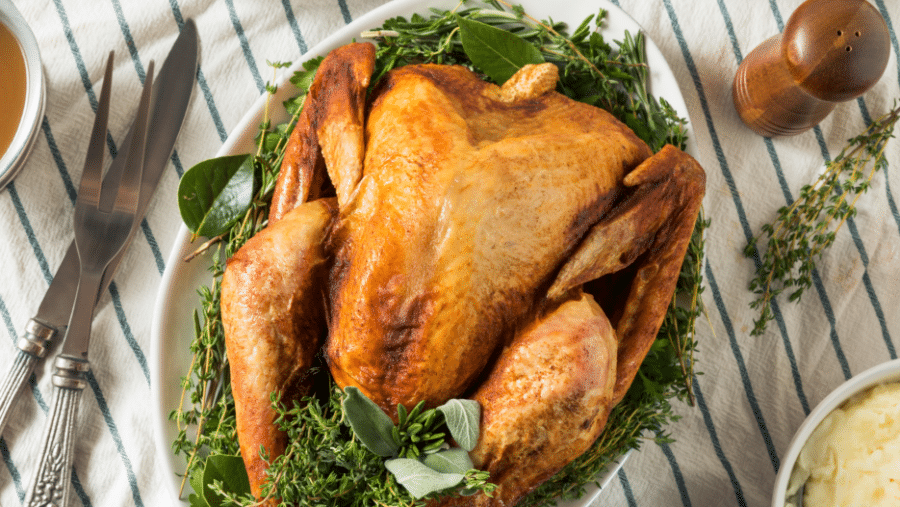Just when it seemed there was nothing left to draw political lines over, the cost of this year’s Thanksgiving meal may bring a little heat from the proverbial kitchen into dinner table conversations this Thursday.
While USDA reports just a moderate to small increase in the price of many Thanksgiving staples, the American Farm Bureau (AFB) saw bigger increases, based on reports from shoppers canvassing their local stores. Meanwhile, the long-term, farm-level share of these retail prices continues to shrink.
The AFB is the decades-old harbinger of just what a Thanksgiving meal costs in the United States of America. The group has been gathering and tabulating retail prices for the traditional family feast every November since 1986. This year, the AFB says consumers will pay more nationwide for Thanksgiving, at an average price of $53.31 for a meal for 10 (with leftovers), compared to $46.90 a year ago. That price is based on an Oct. 26-through-Nov. 8 period.
What does AFB’s dinner include? It covers all the bases with turkey, stuffing, sweet potatoes, rolls with butter, peas, cranberries, a veggie tray, pumpkin pie with whipped cream, and coffee and milk.
Some state-specific meal prices are also available from the AFB. This year, those reports showed Wisconsin buyers as the winners (or losers?) in a heated race to the highest price for a Thanksgiving meal at $71.49 — a 17.25% increase over 2020. Cassie Sonnentag, Wisconsin’s Farm Bureau director of media relations and outreach, said the higher costs were due to everything from processing to transportation, which have all led to increased food prices, particularly in the protein sector.
PRICE COMPARISONS
The Biden administration’s USDA average retail cost for Thanksgiving staples this year is a lot more palatable than figures coming from the AFB, with some of the major differences seen in prices for turkey, cranberries and sweet potatoes.
USDA, for example, reports sweet potatoes this year will cost consumers 83 cents per pound; the AFB price is $1.18 per pound (based on a 3-pound bag). Cranberries, the agency says, cost $2.22 for a 12-ounce bag of fresh. The AFB puts their price at $2.98.
But the real difference between the two groups and their price points is the star of the show, Old Tom. USDA puts a 12-pound frozen turkey at 0.88 cent per pound. The AFB relies on a 16-pound turkey, which it prices out at $23.99 (about $1.50 per pound).
THE FARMERS’ SHARE
In a season of thankfulness, farmers and livestock producers may understandably feel a little of the Grinch coming on when retail prices are mentioned. This year, their place around the table will bring only about 8 cents for every consumer dollar spent. In Indiana, where the AFB reports a meal will cost $53.58, the farmer’s share of that will amount to less than $5.
Isabella Chism, Indiana Farm Bureau second vice president, reports that in her state, shoppers will pay about 12% more than in 2020 for a Thanksgiving meal. She is concerned that farmers are not sharing more in that increase and notes that long-term trends show things are going backward.
“In the mid-1970s, farmers on average received more than 30 cents on the dollar for consumer retail food purchases. We’ve seen a steady decline from year to year since. Hoosier farmers continue to find ways to streamline their operations and decrease costs of production to accommodate for this decline, while still providing safe, affordable food for Hoosiers and families all over the world,” she said.
A CHALLENGING MARKET
Alabama’s Bates Turkey Farm has been in the bird business since 1923. Based at Fort Deposit, the farm’s turkeys are organic, free-range, and produced without antibiotics, hormones or preservatives. They are sold locally through Piggly Wiggly markets but also direct to buyers. Their focus on a niche has put them in a more positive position pricewise, but it has also created challenges.
Cheri Bates Weekley is a third-generation member of the business, working mostly in customer service. She said that this year they will sell about 2,200 head just for Thanksgiving — that doesn’t include their year-round sales or Christmas. She said they’ve seen a downward trend in corporate buyers sending turkeys to clients this year and noted that labor shortages and higher shipping costs have created obstacles for them, just like other businesses.
“Everyone is seeing cuts in profits, especially small businesses,” Weekley told DTN. “All companies have had to absorb some of these higher costs. We can’t just pass it all on to the customers.”
Customers for Bates turkeys come from across the country. Weekley said they sell all the way to the West Coast, but recent increases in shipping costs and reliability have made that a real economic balancing act.
“We have a perishable product, so it has to get there in 72 hours,” she explained. “Regular ground shipping from Alabama to our customers in California or Washington state take five to six days now, so we have to ship by two-day air, and the cost for that can range from $80 to $140.”
On its website this year, Bates is selling an oven-ready, non-basted turkey (12 to 14 pounds in size) for $60.95. That comes out on average between $5.08 and $4.35 per pound. But don’t think that’s all profit. In fact, Weekley said that due to their smaller size, it’s harder to keep input costs down.
“One of the biggest differences between us and the grocery store chains and larger companies like Butterball is that we don’t process as much or raise as much as they do at one time. That means our costs are higher. But what you are getting with that is an all-natural turkey, grown just like we’ve always done it going back to the 1920s, when we were raising turkeys and selling them on the side of the highway. I guess you can say we’re old school, but we still believe that’s the best way.”
###
DTN


